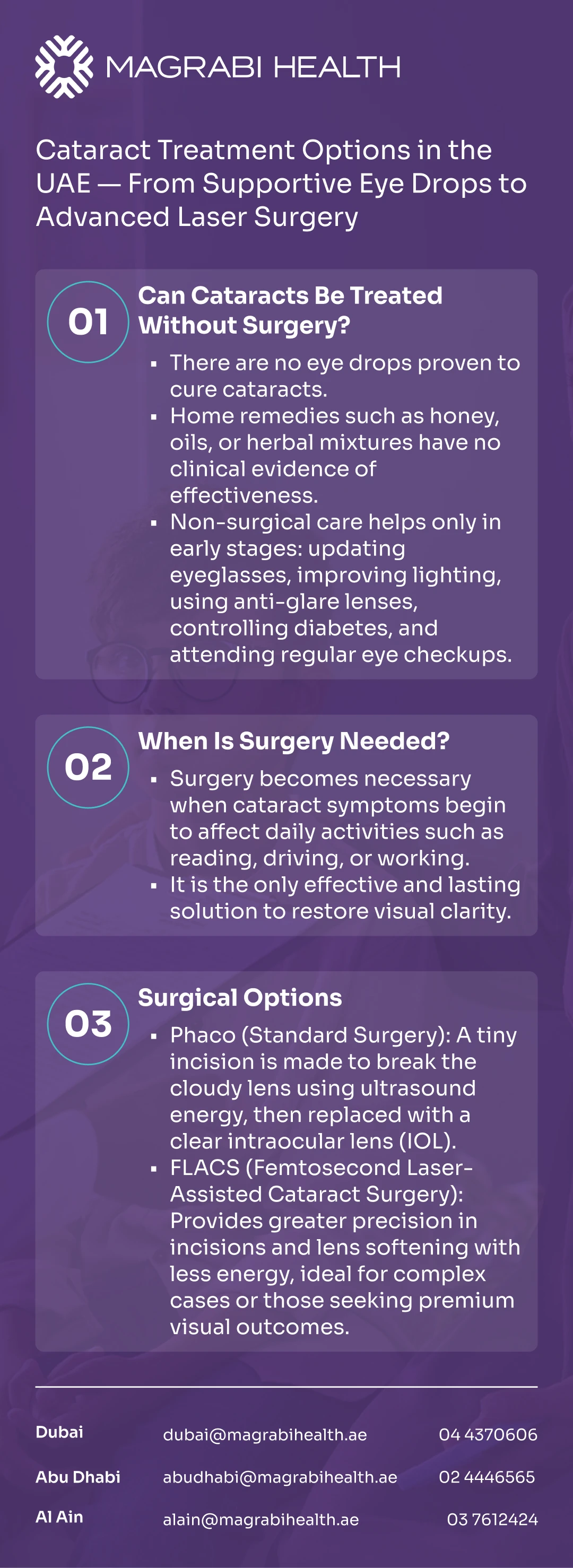Cataracts treatment offers a full range of solutions—from lifestyle adjustments and protective eye drops to advanced laser surgery and premium intraocular lenses. Discover how Magrabi Health Hospitals combine medical precision and personalized care to restore clear, confident vision.
Last updated: 4/11/2025
Cataracts treatment aims to restore clear vision by addressing the clouding of the eye’s natural lens. As cataracts progress, they can cause blurred or dim vision that interferes with reading, driving, or recognizing faces.
In UAE, modern eye care offers a complete range of options — from non-surgical cataract care and eye drops that support eye health, to advanced laser surgery for lasting vision correction.
Understanding these choices helps patients make informed decisions with their ophthalmologist.
Concerned about cloudy or dim vision? Book your personalized consultation today at Magrabi Health and see the world more clearly again.
A cataract is the gradual clouding of the eye’s lens, preventing light from passing clearly to the retina. It’s one of the most common age-related eye conditions worldwide.

Cataracts usually develop slowly, and early signs can be subtle but affect daily vision over time. Common symptoms include
Blurry or cloudy vision
Difficulty seeing at night or in bright sunlight
Faded colors and glare around lights
Frequent changes in eyeglass prescription
Most cataracts develop with age, but other factors accelerate the process:
Diabetes: affects lens metabolism and clarity
Prolonged sun exposure: UV light damages lens proteins
Smoking and alcohol: linked to oxidative stress
Certain medications: such as long-term corticosteroids
Eye injury or surgery: can lead to traumatic cataracts
While aging is the leading cause, maintaining good general and eye health may slow progression.
In the early stages of the condition, many people wonder whether cataracts can be treated without surgery.
Some over-the-counter or “natural” eye drops claim to cure cataracts. However, there is no clinically proven cataract cure in drop form. Prescription eye drops may relieve dryness or inflammation but cannot reverse the clouding of the lens.
Research on pharmacologic “cataract therapy” continues, yet surgical replacement remains the only effective treatment once vision is significantly impaired.
Home remedies for cataract — such as herbal mixtures, honey, or castor oil — lack scientific support. Still, certain lifestyle choices can help protect eye health:
Eat foods rich in antioxidants (vitamin C, E, lutein, zinc).
Stop smoking and limit alcohol.
Use UV-blocking sunglasses outdoors.
These steps promote general ocular health but do not remove existing cataracts.
In early stages, symptoms may be managed without surgery:
Updating eyeglass or contact-lens prescriptions
Using brighter lighting and anti-glare lenses
Managing systemic diseases like diabetes
Scheduling regular eye exams to monitor progress
Such care can delay surgery until vision loss affects daily life.
At Magrabi Health Hospitals, our cataract specialists evaluate every patient’s unique risk factors during a detailed eye examination—ensuring that your treatment plan is personalized, not standardized. Learn more about advanced cataract care, Visit our Cataract Care page.
When cataracts begin to limit daily activities, surgery is the only effective and lasting option.
This is the most common cataract surgery worldwide. Through a tiny incision, the surgeon uses ultrasound to break the cloudy lens into microscopic fragments, which are then gently suctioned out. A clear intraocular lens (IOL) is inserted in its place. The incision usually heals without stitches, and vision often improves within days.
This advanced laser method automates key steps with extreme precision — creating corneal incisions, opening the capsule, and softening the lens. It reduces energy use and may enhance safety and accuracy. It’s ideal for patients seeking premium outcomes or with complex lens conditions.
Depending on lifestyle needs and eye anatomy, several IOL options exist:
Monofocal IOL: sharp focus at one distance; glasses often needed for reading.
Toric IOL: corrects astigmatism for clearer distance vision.
Multifocal or Extended Depth of Focus (EDOF) IOLs: allow near, intermediate, and distance vision with less dependence on glasses.
Most patients notice clearer vision within 24–48 hours. Colors appear brighter, and reading or night driving become easier. Full stabilization takes a few weeks.
Minor temporary side effects such as glare, mild dryness, or halos at night can occur but usually improve with time.
Contact your doctor immediately if you experience sudden pain, redness, or vision loss.
Scientists are exploring pharmacologic “anti-aggregation” compounds that might dissolve or prevent lens protein clumping — essentially a cataract natural treatment. Early lab studies show promise, but no eye drops or medicines have proven effective in humans yet. Until then, surgery remains the only definitive solution for advanced cataracts.
The cataract treatment process is simple and well-organized, guiding patients step by step from diagnosis to recovery. Here’s what to expect along the way:
Comprehensive Eye Exam: Includes vision tests, slit-lamp evaluation, and ocular imaging to assess lens clarity and eye structure.
Personalized Treatment Plan: Your ophthalmologist reviews all cataracts treatment options — from non-surgical care to advanced laser surgery — and helps you select the most suitable intraocular lens (IOL) for your needs.
Surgery Day: Performed under local anesthesia, the procedure takes about 15–20 minutes per eye and is completely painless. Most patients go home within an hour.
Post-Surgery Care: Involves using prescribed eye drops, avoiding eye rubbing, and attending follow-up visits to monitor healing.
Recovery: Most patients regain clear vision within days and quickly return to their normal work and daily activities with improved confidence.
Cataracts treatment has evolved from simple lens replacement to a highly precise, customizable medical procedure. While home remedies and eye drops can support overall eye health, they cannot cure cataracts.
For long-term clarity and safety, surgical treatment — whether standard or laser-assisted — remains the gold standard.
For clear and lasting vision, surgery remains the best solution. Book your expert eye consultation at Magrabi Health Hospitals today.
American Academy of Ophthalmology (AAO). Cataract Treatment and Surgery Guidelines.
National Eye Institute (NEI). Facts About Cataract.
Royal College of Ophthalmologists (RCOphth). Cataract Surgery: Clinical Guidelines.
Mayo Clinic. Cataracts — Diagnosis and Treatment.
This article provides general educational information and should not replace medical advice. Always consult an eye specialist for personalized diagnosis and treatment.
Consultant Ophthalmologist & Cataract and Glaucoma Specialist
Magrabi Health – Abu Dhabi Branch.

Cataract Causes and Risk Factors Explained by Eye Specialists